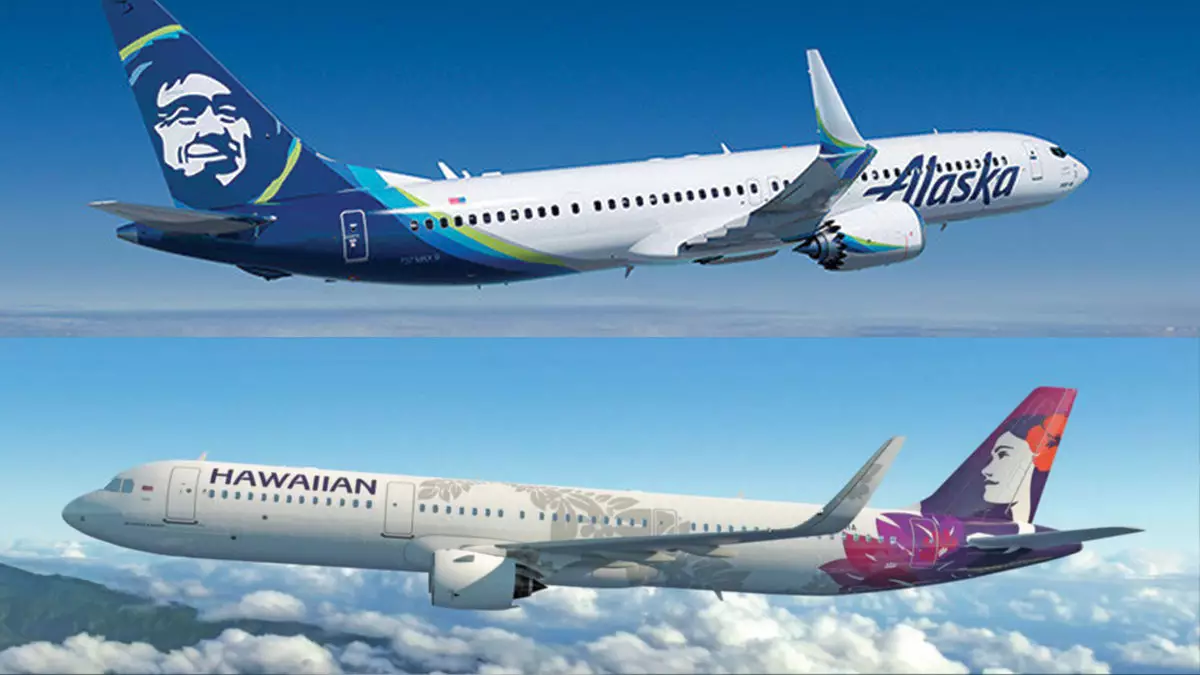The recent announcement that Alaska Airlines is set to finalize its acquisition of Hawaiian Airlines for $1.9 billion has ignited discussions about the potential ramifications for passengers, the airline industry, and the broader market dynamics. After receiving conditional approval from the U.S. Department of Transportation (DOT), Alaska Airlines is on the verge of consolidating operations with Hawaiian. This acquisition promises significant changes, not only for the airlines themselves but also for consumers who rely on these carriers.
The merger faced scrutiny before reaching this stage, notably from the Justice Department, which opted not to challenge the deal after a careful assessment. The DOT’s conditional approval, however, outlines strict parameters that Alaska and Hawaiian must adhere to in order to protect consumer interests and maintain competition within the industry. These regulatory stipulations represent a balanced approach by the DOT to ensure that the merger does not lead to reduced service options or increased prices for consumers, particularly on key routes.
One critical aspect of the approval involves a commitment from the newly formed entity to maintain or enhance flight availability on shared routes. This requirement is particularly significant in popular interisland routes in Hawaii, where reduced competition could adversely impact fares and service quality. By mandating that service levels remain stable or improve, the DOT has placed consumer interests at the forefront of this merger, a move that could enhance public confidence in the regulatory process.
In addition to safeguarding service levels, the DOT’s conditions extend into customer service enhancements that must be adopted by Hawaiian Airlines. As a part of the merger agreement, Hawaiian is required to align its policies with Alaska Airlines, which has been recognized for its customer-friendly initiatives. For instance, the mandate for Hawaiian-branded flights to ensure adjacent seating for families with young children at no additional charge demonstrates a growing trend toward accommodating family travel needs—an increasingly important factor for many consumers in today’s airline landscape.
Furthermore, the imposition of travel credits or frequent flyer miles for significant flight delays aims to address passenger dissatisfaction regarding airline reliability. These conditions reflect an evolving customer-centric approach, where airlines are now held accountable for service disruptions that affect overall travel experiences.
Loyalty Program Integration
Another vital component of this merger is the treatment of loyalty programs, an area where many airlines derive substantial competitive advantage. The commitment from Alaska Airlines to preserve HawaiianMiles values during the transition to Alaska’s Mileage Plan is a crucial step in maintaining customer trust. Ensuring that frequent flyers retain their earned benefits in this shift showcases a dedication to consumer loyalty that is increasingly necessary in a market where brand allegiance is hard-won.
Moreover, by guaranteeing that status benefits remain intact during this period of amalgamation, Alaska Airlines is striving to create a seamless experience for consumers. This careful plan for integration highlights a broader industry trend of prioritizing customer loyalty, which could lead to higher retention rates and customer satisfaction.
From a leadership perspective, the continuity promised through Alaska Airlines’ CEO Ben Minicucci remaining in his position provides a semblance of stability for both carriers. Additionally, the appointment of Joe Sprague from Alaska to lead Hawaiian indicates a unified vision moving forward, which may inspire confidence among employees and stakeholders throughout the transition.
Looking to the future, the combined operational strength of Alaska and Hawaiian Airlines could lead to opportunities for innovation and enhanced service offerings. By pooling resources and expertise, the new entity might be better positioned to compete against larger carriers, ultimately benefiting consumers with more choices and possibly improved pricing structures.
As Alaska Airlines gears up to close its acquisition of Hawaiian Airlines, the resulting merger presents both challenges and opportunities within the airline industry. With stringent regulations from the DOT aimed at safeguarding consumer interests, the future of this combined airline will hinge on its ability to navigate these requirements while delivering value to its passengers. The focus on service levels, customer satisfaction, and loyalty promises a competitive edge that could reinvigorate the travel experience for countless travelers. The industry’s evolution into a more customer-oriented environment, driven by necessitated cooperation from both airlines, could set a new standard in air travel that other carriers might feel compelled to emulate.

